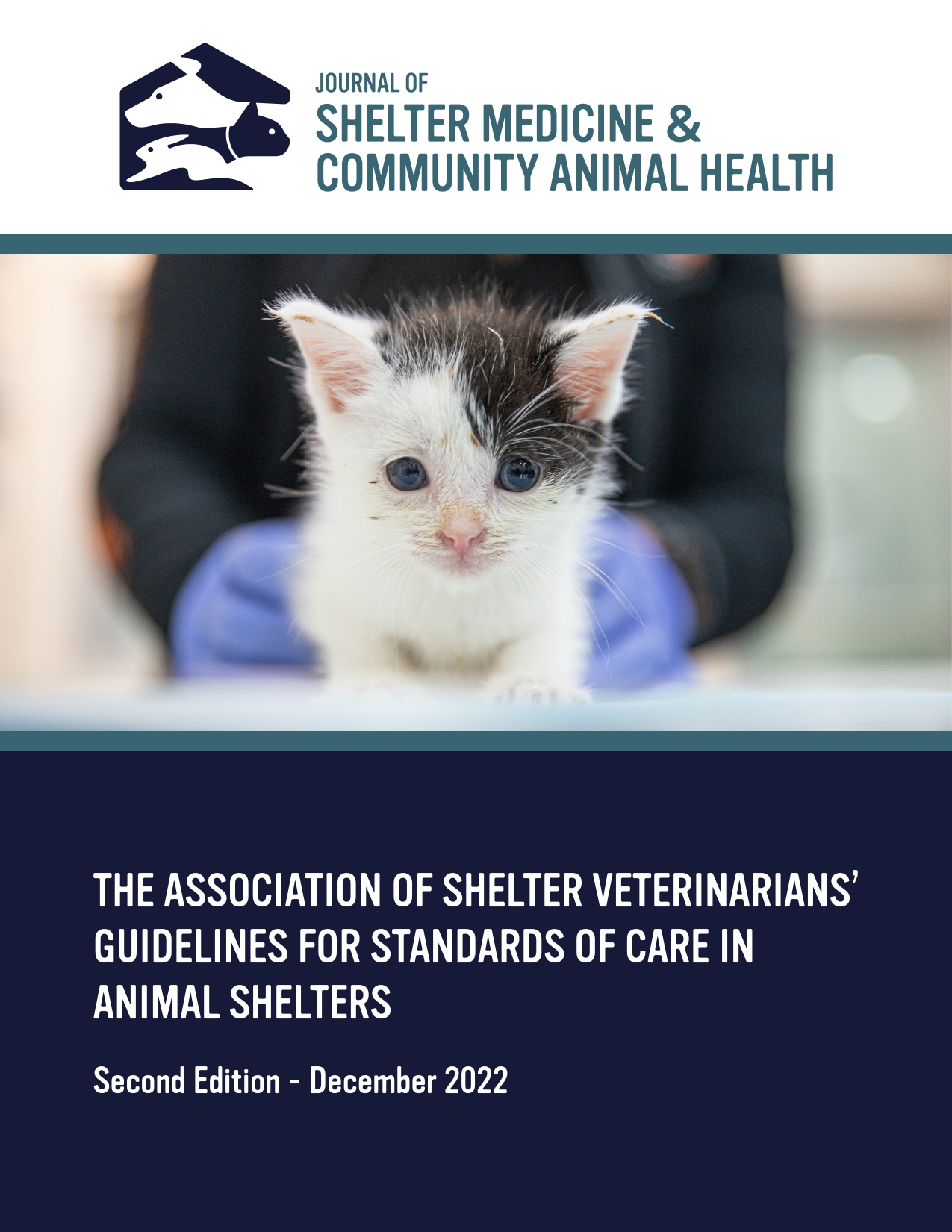A Retrospective, Descriptive Study Of Medical Conditions and Outcomes of Cats Relinquished to an Urban, Limited Admission Shelter from Hoarding Environments
DOI:
https://doi.org/10.56771/jsmcah.v4.148Keywords:
animal hoarding, shelter medicine, dental disease, harm reductionAbstract
Introduction: Animal hoarding is a complex, often underrecognized public health problem affecting the health and welfare of humans and animals. Limited peer review literature exists on the conditions, outcomes, and resources needed to care for cats from hoarding environments in shelter settings. This study investigated intake medical conditions and outcomes of cats surrendered from hoarding environments to the New York City sheltering programs of the American Society for the Prevention of Cruelty to Animals (ASPCA). The objectives of this study were to (1) describe the prevalence of medical conditions at intake; (2) identify associations between medical conditions and outcomes; (3) summarize key interventions provided prior to outcome; and (4) compare outcomes of cats surrendered from hoarding environments to other owner/guardian surrendered (OGS) cats.
Methods: This retrospective, descriptive study examined case records of cats voluntarily surrendered from hoarding cases to ASPCA sheltering programs between January 1, 2021, and July 31, 2023. Demographic, medical, and outcome data were collected on 613 cats relinquished in 34 case groups. Outcome data were compared to 775 non-hoarded OGS cats in-shelter during the same time period.
Results: Only 27.4% of cats were already altered on intake. Dental disease was the most common medical condition (52.8%); 20.3% had moderate to severe disease requiring dentistry procedures. On intake, cats also had otitis externa (33.3%), Upper respiratory infection (URI) (23.8%), ocular disease (21.9%), dermatitis (19.9%), ectoparasites (17.6%), diarrhea (14.2%), dermatophytosis (10.1%), and matting/unkempt fur (4.1%). Once analyzed for interactions, body condition score (BCS) 1–2 (emaciation) at intake (P < 0.001), moderate to severe dental disease (P = 0.007), and increased number of medical conditions per cat (P < 0.001) were associated with non-live outcomes. Over half of cats (57.8%) went to foster homes. Most (63.1%) required antibiotics, and a third (36.4%) received psychopharmaceuticals. Difference in median length of stay (LOS) between hoarded and non-hoarded OGS cats was significant (52 days vs. 28 days; P < 0.001). Proportions of live outcomes for hoarded (89.2%) and non-hoarded cats (88.3%) did not significantly differ (P = 0.6). When euthanasia was the outcome, OGS cats were more often euthanized for medical conditions (64.8%) compared to hoarded cats (45.9%). Behavioral euthanasia rates were significantly higher for hoarded than OGS cats (47.5% vs. 25%; P = 0.017).
Conclusion: The significant need in hoarded cat populations for dentistry and spay/neuter procedures and the significantly longer LOS of hoarded cats suggests organizations working with these populations need to proactively strategize to optimize care delivery without negatively impacting shelter capacity for care. Harm reduction approaches to hoarding employ a collaborative, staged means to reduce populations in the home, including offering surrender of some animals and the provision of spay/neuter and/or other services for remaining animals. This approach, in addition to improving animal welfare, enables the shelter to better manage capacity and resources.
Downloads
References
1.
Hoarding of Animals Research Consortium (HARC). Animal Hoarding: Structuring Interdisciplinary Responses to Help People, Animals and Communities at Risk. Patronek GJ, Loar L, Nathanson JN, eds. 2006. Accessed Sept 25, 2025. https://nationallinkcoalition.org/wp-content/uploads/2023/05/Hoarding-HARC-Report-2006.pdf.
2.
Lockwood R. Animal Hoarding: The Challenge for Mental Health, Law Enforcement, and Animal Welfare Professionals. Behav Sci Law. 2018;36(6):698–716. doi: 10.1002/bsl.2373
3.
Arluke A, Patronek G, Lockwood R, Cardona A. Animal Hoarding. In: Maher J, Pierpoint H, Beirne P, eds. The Palgrave International Handbook of Animal Abuse Studies. Palgrave Macmillan; 2017:107–129. doi: 10.1057/978-1-137-43183-7_6
4.
Lockwood R. Cruelty Toward Cats: Changing Perspectives. In: Salem DJ, Rowan AN, eds. The State of the Animals III: 2005. Humane Society Press; 2005:15–26. Accessed Sept 25, 2025. https://www.wellbeingintlstudiesrepository.org/sota_2005
5.
Polak KC, Levy JK, Crawford PC, Leutenegger CM, Moriello KA. Infectious Diseases in Large-Scale Cat Hoarding Investigations. Vet J. 2014;201(2):189–195. doi: 10.1016/j.tvjl.2014.05.020
6.
Patronek GJ. Hoarding of Animals: An Under-Recognized Public Health Problem in a Difficult-to-Study Population. Vol. 114. Public Health Reports; 1999.
7.
Hoarding of Animals Research Consortium (HARC). Health Implications of Animal Hoarding: Hoarding of Animals Research Consortium. Health Soc Work. 2002;27(2):125–131.
8.
Stumpf B, Calacio B, Branco BC, et al. Animal Hoarding: A Systematic Review. Braz J Psychiatry. 2023;45(4):356–365. doi: 10.47626/1516
9.
Strong S, Federico J, Banks R, Williams C. A Collaborative Model for Managing Animal Hoarding Cases. J Appl Anim Welf Sci. 2019;22(3):267–278. doi: 10.1080/10888705.2018.1490183
10.
Jacobson LS, Giacinti JA, Robertson J. Medical Conditions and Outcomes in 371 Hoarded Cats From 14 Sources: A Retrospective Study (2011–2014). J Feline Med Surg. 2020;22(6):484–491. doi: 10.1177/1098612X19854808
11.
Tamimi B, Kisiel L, Dolan E, Berliner E. A Retrospective Study of Cat Hoarding Cases and Their Management Through Voluntary Spay/Neuter and Relinquishment In New York City. J Shelter Med Community Anim Health. 2024;3(1). doi: 10.56771/jsmcah.v3.92
12.
Tompkins MA. Clinician’s Guide to Severe Hoarding. Springer; 2015:49–56.
13.
Bernstein M, Wolf BM. Time to Feed the Evidence: What to Do With Seized Animals. 2005. Accessed Sept 25, 2025. https://heinonline.org/HOL/LandingPage?handle=hein.journals/elrna35&div=60&id=&page=
14.
Jacobson LS, Ellis JJ, Janke KJ, Giacinti JA, Robertson JV. Behavior and Adoptability of Hoarded Cats Admitted to an Animal Shelter. J Feline Med Surg. 2022;24(8):e232–e243. doi: 10.1177/1098612X221102122
15.
Eagan BH, Van Haaften K, Azadian A, Protopopova A. The Use of Psychoactive Medications and Non-medication Alternatives for Cats and Dogs in North American Animal Shelters and Rescues. J Shelter Med Community Anim Health. 2025;4(1). doi: 10.56771/jsmcah.v4.148
16.
Eagan BH, van Haaften K, Protopopova A. Daily Gabapentin Improved Behavior Modification Progress and Decreased Stress in Shelter Cats from Hoarding Environments in a Double-Blind Randomized Placebo-Controlled Clinical Trial. J Am Vet Med Assoc. 2023;261(9):1305–1315. doi: 10.2460/javma.23.01.0044
17.
World Organization for Animal Health. Animal Welfare: The Five Freedoms. 2025. Accessed Jul 7, 2025. https://www.woah.org/en/what-we-do/animal-health-and-welfare/animal-welfare/
18.
Laflamme D. Development and Validation of a Body Condition Score System for Cats: A Clinical Tool. Feline Pract. 1997;25(5–6):13–18.
19.
Bellows J, Berg ML, Dennis S, et al. 2019 AAHA Dental Care Guidelines for Dogs and Cats*. J Am Anim Hosp Assoc. 2019;55(2):49–69. doi: 10.5326/JAAHA-MS-6933
20.
American Veterinary Medical Association. AVMA Pet Ownership and Demographics Sourcebook. American Veterinary Medical Association; 2018.
21.
Steneroden KK, Hill AE, Salman MD. A Needs-Assessment and Demographic Survey of Infection-Control and Disease Awareness in Western US Animal Shelters. Prev Vet Med. 2011;98(1):52–57. doi: 10.1016/j.prevetmed.2010.11.001
22.
Lee D Bin, Verstraete FJM, Arzi B. An Update on Feline Chronic Gingivostomatitis. Veterinary Clinics of North America – Small Animal Practice. 2020;50(5):973–982. doi: 10.1016/j.cvsm.2020.04.002
23.
Peralta S, Carney PC. Feline Chronic Gingivostomatitis is More Prevalent in Shared Households and its Risk Correlates with the Number of Cohabiting Cats. J Feline Med Surg. 2019;21(12):1165–1171. doi: 10.1177/1098612X18823584
24.
Levy JK, Scott HM, Lachtara JL, Crawford PC. Seroprevalence of Feline Leukemia Virus and Feline Immunodeficiency Virus Infection among Cats in North America and Risk Factors for Seropositivity. J Am Vet Med Assoc. 2006;228(3):371–376. doi: 10.2460/javma.228.3.371
25.
The Association of Shelter Veterinarians. The Guidelines for Standards of Care in Animal Shelters: Second Edition. Journal of Shelter Medicine and Community Animal Health. 2022;1(1). doi: 10.56771/ASVguidelines.2022
26.
24Pet. ShelterWatch Report. 2025. Accessed May 19, 2025. https://services.24pet.com/ShelterWatch/
27.
Karsh EB, Turner DC. The Human-Cat Relationship. In: Turner DC, Bateson P, eds. The Domestic Cat: The Biology of Its Behaviour. Cambridge University Press; 1988:67–81.
28.
Ellis JJ, Janke KJ, Furgala NM, Bridge T. Post-Adoption Behavior and Adopter Satisfaction of Cats Across Socialization Likelihoods. Journal of Shelter Medicine and Community Animal Health. 2025;4(1). doi: 10.56771/jsmcah.v4.116
29.
Brown WP, Stephan VL. The Influence of Degree of Socialization and Age on Length of Stay of Shelter Cats. Journal of Applied Animal Welfare Science. 2021;24(3):238–245. doi: 10.1080/10888705.2020.1733574
30.
Cussen VA, DiGangi BA. Welfare and Ethical Decision-Making. In: DiGangi BA, Cussen VA, Reid PJ, Collins KA, eds. Animal Behavior for Shelter Veterinarians and Staff. 2nd ed. John Wiley & Sons, Inc; 2022:479–503.
31.
American Veterinary Medical Association. AVMA Guidelines for the Euthanasia of Animals: 2020 Edition. American Veterinary Medical Association; 2020.

Additional Files
Published
Issue
Section
License
Copyright (c) 2025 Daniela Lopez Goicochea, Margaret Slater, Elizabeth A. Berliner

This work is licensed under a Creative Commons Attribution 4.0 International License.









